

The 7 Biggest Challenges in Merging Design and Business. Recently, I gave a speech at the RGD Design Thinkers event here in Toronto.
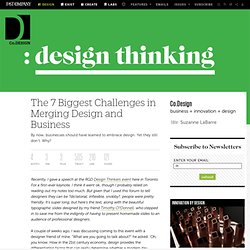
For a first-ever keynote, I think it went ok, though I probably relied on reading out my notes too much. But given that I used this forum to tell designers they can be ? Dictatorial, inflexible, snobby? , people were pretty friendly. It's super long, but here's the text, along with the beautiful typographic slides designed by my friend Timothy O? A couple of weeks ago, I was discussing coming to this event with a designer friend of mine. Now bear in mind that this was a designer talking! That he didn't was more than just an affront to my ego. And yet, we know in reality that they were never actually handed over.
In fact, if we take a close look at our world and environment and businesses and systems and services, we must accept that we're not generally surrounded by gloriousness, at least any more than we were before this supposed grand renaissance. ? Design has been democratized. Educational Resources for Studying Graphic Design. Feb 14 2011 One of the greatest things about having access to the Internet, is the educational opportunities that it affords the public.
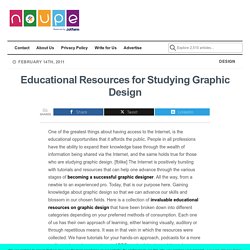
People in all professions have the ability to expand their knowledge base through the wealth of information being shared via the Internet, and the same holds true for those who are studying graphic design. The Internet is positively bursting with tutorials and resources that can help one advance through the various stages of becoming a successful graphic designer. All the way, from a newbie to an experienced pro. Today, that is our purpose here. Here is a collection of invaluable educational resources on graphic design that have been broken down into different categories depending on your preferred methods of consumption. We have tutorials for your hands-on approach, podcasts for a more auditory take and an assortment of PDFs and articles to read through. PDFs. Steve Jobs, a designer at heart. We at WDD are deeply saddened by Steve Jobs’ passing… And while the Internet is buzzing with people’s heartfelt emotions about his life’s impact and legacy, we’d also like to pay tribute with this modest homage.
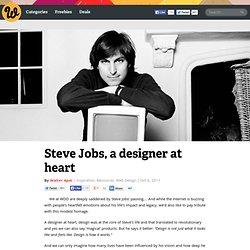
A designer at heart, design was at the core of Steve’s life and that translated to revolutionary and yes we can also say ‘magical’ products. But he says it better: “Design is not just what it looks like and feels like. Design is how it works.” And we can only imagine how many lives have been influenced by his vision and how deep he reached into all the corners of the world… In this post, we’ve collected some rare photos of Steve as well as some famous quotes that depict his visions and personality. Comments are open for you to share how he impacted your career as a designer and as a person, we sure know that he has deeply influenced us!
“Your work is going to fill a large part of your life, and the only way to be truly satisfied is to do what you believe is great work. Mike Kruzeniski – How Print Design is the Future of Interaction. This post describes “How Print Design is the Future of Interaction,” a talk I gave at SXSW Interactive on March 12, 2011.
The slides from the talk are available to view on Slideshare, and you can see some of the discussion that followed on Twitter here. Introduction There are three areas that I covered in the talk. First, how the visual language of UI has evolved and been shaped in to what we find in the interfaces we are familiar with today. Second, I’ll discuss why I think a new approach to the visual design of interfaces, influenced by Print Design, is emerging and necessary. When I talk about “Print” here, I’m not interested in the literal transfer of printed media on to screen, like we see in some applications which try to recreate the exact textures and layouts of newspapers, for example.
Quotes on Design. The Shape of Design by Frank Chimero. EDIT: Updated details on shipping, especially for our international friends.
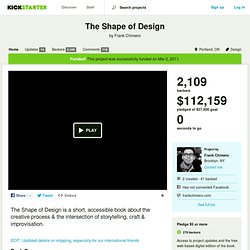
Hi. My name's Frank Chimero. I've spent the better part of the last two years writing and speaking on design and thinking about the topics that orbit the practice: storytelling, concept, craft, and improvisation. The Principles of Design. The web professional's online magazine of choice.
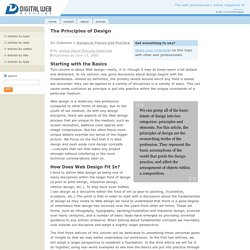
In: Columns > Design in Theory and Practice By Joshua David McClurg-Genevese Published on June 13, 2005 Starting with the Basics This column is about Web design—really, it is—though it may at times seem a bit distant and distracted. Kicker Studio: The Disciplines of User Experience. UPDATE: I updated this diagram in 2009 for the second edition of Designing for Interaction that addresses some of the shortcomings I note below.
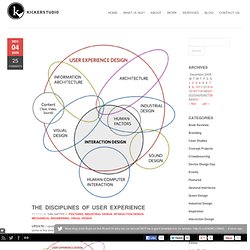
The diagram now looks like this (click for larger image): Like almost nothing I’ve done, a model that I put in my first book Designing for Interaction showing the overlapping disciplines of user experience/experience design has been referenced repeatedly in various places. The problem is I was never very happy with the diagram. For one thing, it’s missing architecture in there, which is becoming increasing important. So I redrew it: Click for a larger image or download the pdf. Cartographie de la recherche en design.